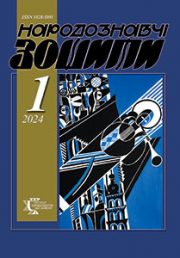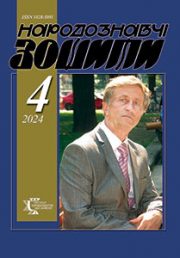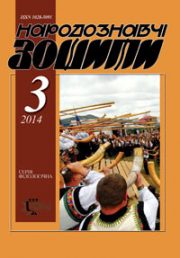The Ethnology Notebooks. 2022. № 1 (163), 97—104
UDK 75.041.5.071.1(71=161.2)”19/20″І.Р.Носик
DOI https://doi.org/10.15407/nz2022.01.097
PORTRAITS AND SELF-PORTRAIT AS A SOURCE OF CREATIVE INSPIRATION OF IRENA NOSYK
PAVLYSHYN Anastasiia
- ORCID ID: http://orcid.org/0000-0003-4316-3144
- Master’s degree of Arts,
- PhD, LNAM,
- 38, Kubiiovycha Street, 79011, Lviv, Ukraine,
- Contacts: e-mail: pereskokova.nastia@gmail.com
Abstract. The article reveals the peculiarities of the portrait genre of art in the works of Ukrainian artist from diaspora — Irena Romana Nosyk. The following types of portraits are analyzed as, bust parade portraits: «Student», «Young boy», «Woman in red»; family: «Portrait of a father», «Portrait of a grandfather», «Portrait great-uncle». Costumed portraits: «Negro», «Gypsy». Bust graphic portraits: «Portrait of a man», «Girl’s head», «Portrait of a woman», and a portrait of «Old man». As well as a self-portrait of 1956—1957 of a young lady aged 25, made in oil.
The article gives a general description of the research question on the history of portraiture as a genre of painting. Brief biographical information about the artist, her creative activity is considered. The influence of the art school of Professor Tony Kirchmeier from the Innsburg Academy of Arts and the portrait work of Irena Nosyk can be traced. The personal attitude of the artist to the object of research is covered.
The main issues of portrait image theory are clarified. The main role of cognitive processes (perception, imagination and thinking) during the work on the image of a person is analyzed. Certain regularities of the composition of the portrait, features of work with oil paints in the image are fixed. The originality of the artist’s color and tonal palette is highlighted. Light-shadow contrasts are analyzed. The main features of the styles in which the artist worked in the genre of «Portrait» are substantiated, namely: expressionism, modernism, cubism, and neo-impressionism.
The regularity of the influence of cultural archetypes as permanent images for depiction is revealed. The artist ’s desire to achieve equal opportunities for the transfer of images as in painting with the help of lines, strokes, dots and spots of empty space in graphics is traced. The general description of Irena Nosyk’s self-portrait as a kind of confession of the author is given, which gives an opportunity to show the spiritual depth of art work.
The conclusions of the research on the genre of portrait and self-portrait as a source of creative inspiration for Irena Romana Nosyk are made in the conclusions.
The research methodology is based on the application of the principles of science, objectivity and historicism. To reveal the compositional, figurative and content solutions of the artist’s works, the method of art analysis is used.
Keywords: portrait, self-portrait, art of Irena Romana Nosyk, Ukrainian painting of the XX—XXI centuries.
Received 18.01.2022
REFERENCES
- Sotska, G., & Shmelova, T. (Eds.). Dictionary of artistic terms. Retrieved from: http://e-kontsept.ru/2017/574026.htm (Last accessed: 12.10. 2021).
- Vipper, B. The problem of similarity in the portrait. Retrieved from: https://litresp.ru/chitat/ru/%D0%92/vipper-boris-robertovich/vvedenie-v-istoricheskoe-izuchenie-iskusstva/9 (Last accessed: 01.11.2021).
- Savinykh, M., & Sofronov, G. Features of image transfer in portrait painting. Retrieved from: http://e-kontsept.ru/2017/574026.htm (Last accessed: 12.10. 2021).
- Pavlyshyn, A. (2021). Confession in self-portraits of Irena Romana Nosyk. Theses of the conference are historical and current aspects of the methodology of Professional Art Education in Ukraine. Lviv [in Ukrainian].
- Yablonskaya, T. (1978). Classification of the portrait genre in Russia in the eighteenth century: The thesis for the academic degree of kand. nauk. Moskva [in Russian].
- Darevich, D. Art and the microscope in the life of Irena Nosik. Retrieved from: https://era.library.ualberta.tsa/items/5e0831fa-0867-4464-be9f-0b33210a9040/viev/ts5d4ad3d-1a07-44b5-9f4d-a3ts9efd29714/ZKZ_2020_8.pdf (Last accessed: 01.11.2021).






